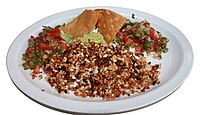.mw-parser-output .hidden-begin{box-sizing:border-box;width:100%;padding:5px;border:none;font-size:95%}.mw-parser-output .hidden-title{font-weight:bold;line-height:1.6;text-align:left}.mw-parser-output .hidden-content{text-align:left}@media all and (max-width:500px){.mw-parser-output .hidden-begin{width:auto!important;clear:none!important;float:none!important))You can help expand this article with text translated from the corresponding article in Spanish. (January 2021) Click [show] for important translation instructions.
View a machine-translated version of the Spanish article.
Machine translation, like DeepL or Google Translate, is a useful starting point for translations, but translators must revise errors as necessary and confirm that the translation is accurate, rather than simply copy-pasting machine-translated text into the English Wikipedia.
Do not translate text that appears unreliable or low-quality. If possible, verify the text with references provided in the foreign-language article.
You must provide copyright attribution in the edit summary accompanying your translation by providing an interlanguage link to the source of your translation. A model attribution edit summary is Content in this edit is translated from the existing Spanish Wikipedia article at [[:es:Escamol]]; see its history for attribution.
You may also add the template ((Translated|es|Escamol)) to the talk page.
For more guidance, see Wikipedia:Translation.
 Escamoles cooked in butter | |
| Alternative names | Mexican caviar |
|---|---|
| Place of origin | Mexico |
| Main ingredients | larvae and pupae of ants |
Escamoles (Spanish: [eskaˈmoles] ; Nahuatl languages: azcamolli,[1] from azcatl 'ant' and molli 'puree'[2]), known colloquially as Mexican caviar or insect caviar, are the edible larvae and pupae of ants of the species Liometopum apiculatum and L. occidentale var. luctuosum.[3] They are most commonly consumed in Mexico City and surrounding areas.[4] Escamoles have been consumed in Mexico since the age of the Aztecs.[5][6] The taste is described as buttery and nutty, with a texture akin to that of cottage cheese.[7]
-
Escamoles al mojo de ajo













